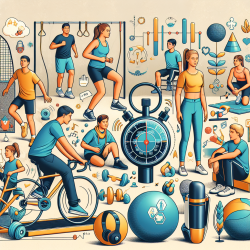Introduction
In the realm of speech-language pathology and child development, the integration of physical activity into therapeutic practices is gaining traction. A recent study, "Time-efficient physical activity intervention for older adolescents with disability: rationale and study protocol for the Burn 2 Learn adapted (B2La) cluster randomised controlled trial," highlights the significance of incorporating high-intensity interval training (HIIT) into school settings for adolescents with disabilities. This blog explores how practitioners can leverage these findings to enhance therapeutic outcomes.
The B2La Intervention: A Closer Look
The B2La intervention is designed to address the declining physical activity levels among adolescents with disabilities. The program involves the implementation of HIIT sessions, tailored to meet the unique needs of students with disabilities. These sessions are integrated into specialist support classes, providing a structured yet adaptable framework for physical activity.
Key Outcomes of the Study
The study's primary outcome is the improvement in functional capacity, assessed through the 6-minute walk/push test. Secondary outcomes include enhancements in physical activity levels, muscular fitness, body composition, cognitive function, quality of life, and classroom behavior. The intervention also aims to be cost-effective and sustainable, with evaluations conducted to assess its adaptability and acceptability in school settings.
Implementing the Findings in Practice
For practitioners in speech-language pathology and related fields, integrating physical activity into therapy sessions can be transformative. Here are some strategies to consider:
- Incorporate HIIT into Therapy Sessions: Utilize short, high-intensity exercises to engage students physically and cognitively. This approach can enhance attention, memory, and overall engagement in therapeutic activities.
- Collaborate with Educators: Work closely with teachers to integrate physical activity into the school day. This collaboration can ensure that interventions are consistent and reinforce therapeutic goals.
- Customize Activities: Tailor exercises to the individual needs of each student, considering their physical abilities and therapeutic goals. This customization ensures that all students can participate and benefit from the activities.
Encouraging Further Research
While the B2La study provides a robust framework, further research is essential to explore the long-term impacts of HIIT on adolescents with disabilities. Practitioners are encouraged to document their experiences and outcomes, contributing to a growing body of evidence that supports the integration of physical activity in therapeutic settings.
Conclusion
The B2La intervention offers a promising approach to enhancing physical, cognitive, and emotional outcomes for adolescents with disabilities. By integrating these findings into practice, practitioners can contribute to more holistic and effective therapeutic interventions. To read the original research paper, please follow this link: Time-efficient physical activity intervention for older adolescents with disability: rationale and study protocol for the Burn 2 Learn adapted (B2La) cluster randomised controlled trial.










